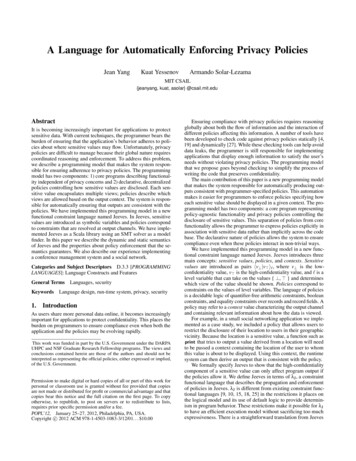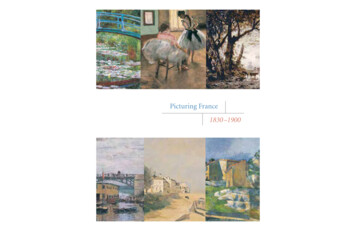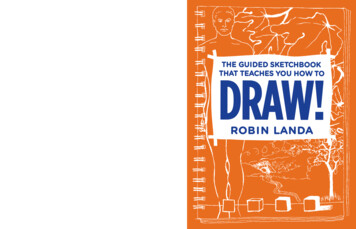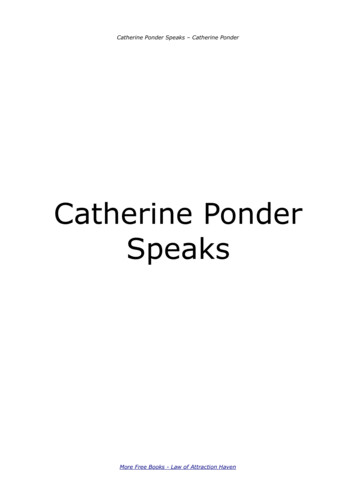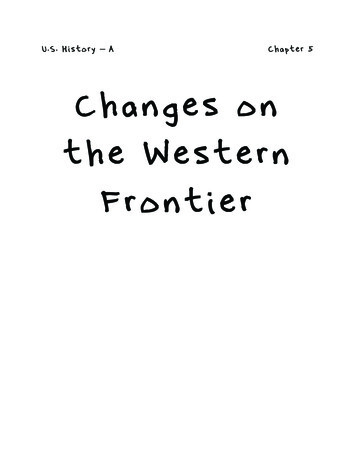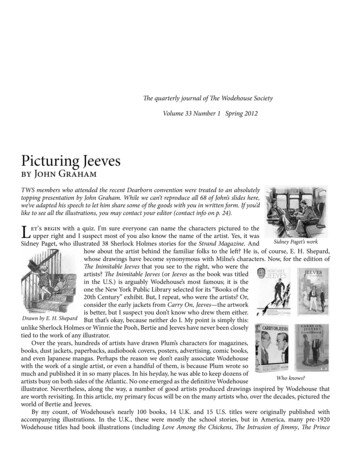
Transcription
The quarterly journal of The Wodehouse SocietyVolume 33 Number 1 Spring 2012Picturing Jeevesby John GrahamTWS members who attended the recent Dearborn convention were treated to an absolutelytopping presentation by John Graham. While we can’t reproduce all 68 of John’s slides here,we’ve adapted his speech to let him share some of the goods with you in written form. If you’dlike to see all the illustrations, you may contact your editor (contact info on p. 24).Let’s begin with a quiz. I’m sure everyone can name the characters pictured to theupper right and I suspect most of you also know the name of the artist. Yes, it wasSidney Paget’s workSidney Paget, who illustrated 38 Sherlock Holmes stories for the Strand Magazine. Andhow about the artist behind the familiar folks to the left? He is, of course, E. H. Shepard,whose drawings have become synonymous with Milne’s characters. Now, for the edition ofThe Inimitable Jeeves that you see to the right, who were theartists? The Inimitable Jeeves (or Jeeves as the book was titledin the U.S.) is arguably Wodehouse’s most famous; it is theone the New York Public Library selected for its “Books of the20th Century” exhibit. But, I repeat, who were the artists? Or,consider the early jackets from Carry On, Jeeves—the artworkis better, but I suspect you don’t know who drew them either.Drawn by E. H. Shepard But that’s okay, because neither do I. My point is simply this:unlike Sherlock Holmes or Winnie the Pooh, Bertie and Jeeves have never been closelytied to the work of any illustrator.Over the years, hundreds of artists have drawn Plum’s characters for magazines,books, dust jackets, paperbacks, audiobook covers, posters, advertising, comic books,and even Japanese mangas. Perhaps the reason we don’t easily associate Wodehousewith the work of a single artist, or even a handful of them, is because Plum wrote somuch and published it in so many places. In his heyday, he was able to keep dozens ofWho knows?artists busy on both sides of the Atlantic. No one emerged as the definitive Wodehouseillustrator. Nevertheless, along the way, a number of good artists produced drawings inspired by Wodehouse thatare worth revisiting. In this article, my primary focus will be on the many artists who, over the decades, pictured theworld of Bertie and Jeeves.By my count, of Wodehouse’s nearly 100 books, 14 U.K. and 15 U.S. titles were originally published withaccompanying illustrations. In the U.K., these were mostly the school stories, but in America, many pre-1920Wodehouse titles had book illustrations (including Love Among the Chickens, The Intrusion of Jimmy, The Prince
and Betty, The Little Nugget, Something New, UneasyMoney, and Piccadilly Jim). In 1932, Doubleday Doranpublished Hot Water with a colorful dust wrapper andseven simple line drawings by Rea Irvin, who hadcreated the iconic man-about-town Eustace Tilley forthe New Yorker magazine. There were only two Jeevesbooks with illustrations. Paul Galdone, a Hungarianimmigrant best known for illustrating children’s books,drew Joy in the Morning, and Hal McIntosh, a ScottishCanadian artist, did The Mating Season.With books, the most obvious place to find artworkis the dust jacket. It is clear from his letters thatWodehouse did not hold a particularly high opinion ofthe jackets issued by his main British publisher, HerbertJenkins. Writing to his friend Bill Townend in 1945,Plum says: “It is nice to feel that the Jenkins people wantme . . . it is only their jackets that jar one, and I supposeyou are apt to get a pretty foul jacket from any popularpublisher. I sometimes wish I were one of those dignifiedbirds whose books came out in grey wrappers withthe title and author’s name on them and nothing else.God may have forgivenHerbert Jenkins Ltd. forthe jacket of Meet Mr.Mulliner, but I nevershall.” I don’t know whyWodehousesingledout Mr. Mulliner forNot Plum’s favoriteparticular disdain, butit is true that Herbert Jenkinsrarely employed first-rate talents,although one well-known Britishartist, W. Heath Robinson,produced the jacket for If I WereYou. If it looks like there are a lotof spray bottles and tonics in thisbarber shop, it might help you toknow that Heath Robinson wasthe Rube Goldberg of the U.K.,famous for drawing pictures W. Heath Robinsonof unnecessarily complicatedmachinery.The only dust jacket we knowthat Wodehouse particularlyliked was the one Faber andFaber produced for Louderand Funnier. The artwork is byRex Whistler, who was both amuralist and book illustrator.His dust jackets were famousfor their old-fashioned style andPlum preferredornate baroque borders.2Plum Lines Vol. 33 No. 1 Spring 2012Up until the Second World War, it is probablyfair to say that more readers got their Wodehousefrom magazines than anywhere else, since just abouteverything he wrote appeared there first. McIlvaine’sbibliography records 153 different magazines withWodehouse stories, and the 2001 Addendum hasadded many more titles to the list; as a result, the totalnumber of illustrators who drew a Wodehouse storyis impossible to guess. The Strand magazine aloneemployed 27 different artists to illustrate the over200 stories he published there. By the way, althoughSidney Paget never illustrated a Wodehouse story, E. H.Shepard did. Shepard drew five of Plum’s stories for theStrand, including “The Rough Stuff.”As you know, the earliest Jeeves stories appeared inthe Saturday Evening Post in the U.S. If we count 1915’s“Extricating Young Gussie” as part of the official canon,then the first artist to illustrate a Jeeves story was MartinJustice. Justice sketched Bertie (Mannering-Phipps)and his Aunt Agatha, but did not draw Jeeves—whichis hardly surprising since Jeeves barely enters the story.The credit for the first picture of Jeeves and of BertieWooster goes to Tony Sarg, who illustrated both “LeaveIt to Jeeves” and “The Aunt and the Sluggard” for thePost in 1916. Sarg’s Bertie is quite old and rather pudgy;his Jeeves is tall, thin and dignified. Of course, one hasto remember that at this early stage, Sarg had little byway of character description to build on; Bertie tellsTony Sarg’spudgy Bertieus that “Jeeves is a tallish man, with one of those dark,shrewd faces,” but he says little about himself, otherthan admitting: “I’m a bit short on brain myself; the oldbean would appear to have been constructed more forornament than for use, don’t you know.”Tony Sarg was born in Guatemala in 1882 toGerman parents. He eventually moved to London andthen on to New York City, where he did graphic designfor advertisers and magazine publishers. Said to befascinated by marionettes, he designed some of the firstballoon puppets for the Macy’s Thanksgiving Day parade.He never illustrated any more Jeeves stories after 1916,but he did draw some of Plum’s golf stories for McClure’s
magazine in the1920s.In the U.K.,the first sixJeevesstoriesappeared in theStrand betweenJanuary1916andAugustAlfred Leete’s Jeeves and Bertie1918.Allsix were illustrated by Alfred Leete. Above you cansee Leete’s very first drawing of Jeeves and an earlylook at Bertie. Leete always pictures Jeeves with amilitary bearing and prominent forehead. This latercharacteristic probably stems from a line in “Jeeves andthe Unbidden Guest.” On hearing that Lady Malvern’sson Wilmot has landed in prison, Bertie tells us: “Achappie has to be a lot broader about the forehead thanI am to handle a jolt like this.” Needless to say, Jeevescould handle the jolt and has the forehead to prove it.Leete’s Bertie is that he is not chubby, but he is still tooold for my taste. Leete illustrated only six Jeeves stories,but he drew 21 Wodehouse stories in all, including twoReggie Peppers and The Man of Means. Leete is notablefor another reason: although the work is uncredited, Ithink it is pretty clear he drew the dust jacket art for thefirst Jeeves book, My Man Jeeves, in 1919. He probablyalso did the covers for several later reprints.At the Strand, Alfred Leete illustrated stories for36 different authors. In 1914, he drew a cover for themagazine London Opinion featuring Lord Kitchener,which became the iconic World War I British recruitingposter “Your Country Needs You.” Leete died in 1933,but his last Wodehouse book cover did not appearuntil much later. In the 1990s, Penguin borrowed theupper lefthand corner of a poster Leete had done for theLondon Underground in the 1920s for their paperbackreprint of The Code of the Woosters. As such, I think wecan credit Leete with having the longest career of anyWodehouse illustrator.Back in the U.S., the Post switched illustratorsfor their next three Jeeves stories. The new artist wasHenry Raleigh, whofor many years haddepicted fashionablesociety for MaxwellHouse coffee ads.Raleigh gives usa much youngerBertie; his JeevesHenry Raleigh depicts the prize-giving shows the properscene from Right Ho, Jeeves.feudal spirit, but Inotice something else. In “Jeeves and the Hard-BoiledEgg,” Bertie’s pal Bicky, staring at Jeeves in awe, asks:“Have you ever noticed his head, Bertie old man? It sortof sticks out at the back.” This is a line Raleigh really tookto heart, or should I say to head. In December 1933,Henry Raleigh would return to the Post to illustrateRight Ho, Jeeves. The drawings he produced for this sixpart serial are to my mind some of the best we have,including one of Gussie emerging from under Bertie’sbed (used on the cover of Who’s Who in Wodehouse).And below left, of course, is the prize-giving scene.In December 1921, the Strand began a new seriesof 11 short stories that in book form would become TheInimitable Jeeves. In the U.S., these stories were publishednot in the Post but in Cosmopolitan. Both the Strand andCosmopolitan chose new artists, and to my mind, neitherchose all that wisely. Let’s begin with Cosmopolitan. Theartist was Thornton Drake Skidmore, or T. D. Skidmoreas he signed his work. One critic saidSkidmore “excelled at scenes of wellheeled, fashionably dressed couplesrendered in a flattened graphic style andfeaturing bold contours.” In the early1920s, Cosmopolitan used Skidmore toillustrate 31 Wodehouse short stories,from Archie to Jeeves to Ukridge. Hisassignments included some of Plum’s alltime best, including “The Great Sermon One of T. D.Handicap” and “Ukridge’s Accident Skidmore’sSyndicate.” His artwork is technicallysobercompetent, but to my mind his drawingsattemptslack humor.There is one interesting story about Skidmore. Asfar as I can tell, Wodehouse rarely took an interest inhis illustrators and often had no idea who they wereor what they were drawing. But after Cosmopolitanpublished “Ukridge’s Dog College,” Plum wrote to BillTownend: “I had to rush that story in the most horribleway . . . and had to write about 20,000 words before I gotit set. And then . . . I foundthat the artist [Skidmore]had illustrated a scene whichwas not in the final version,and I had to add a new oneby telephone.” I think this isthe illustration in question:Ukridge, one cat, and a packof Pekes. In the book versionof the story, Ukridge ratherSkidmore’s somewhatbizarrely says he is dragginglivelier version ofa dead cat; happily, in theUkridge’s Peke trainingCosmopolitan version the catPlum Lines Vol. 33 No. 1 Spring 20123
is very much alive, andleading the way. Thankyou, T. D. Skidmore!In the U.K., the Strandhad selected A. WallisMills to illustrate the newJeeves stories. He wouldstay with the Strand fora total of 34 Wodehousestories, including a runof 14 Jeeves stories. MillsA. Wallis Millsholds the record forin the Strandhaving drawn the mostJeeves short stories of any artist. The best that can besaid for his drawings is that they show humor, unlikethose of Skidmore. He was not averse to having Jeevesshow emotion, as above where Jeeves reacts with disdainto Bertie’s new cummerbund. As you might expect,H. J. Mowat’s BertieArthur William Brown gets rummy.Bertie also shows strong emotionon occasion. Overall, Mills’s take onboth Bertie and Jeeves is credible;what disappoints is that hisdrawings are often so small in sizeand scope. For whatever reason, theStrand never seemed to give MillsGeorge Wright’smuch space or attention.young BertieAfter a nearly four-year hiatusfrom the Post, Wodehouse returned there in 1923 withLeave It to Psmith, illustrated by May Wilson Preston,the only female artist of note to draw Wodehouse.Preston had studied art with James Whistler in Paris.Her appearances in the Post and elsewhere wereextensive; although she never drew a Jeeves story, herWodehouse credits include the magazine illustrationsand dust jacket art for five novels.With Plum’s return to the Post, his next three Jeevesstories appeared there in the mid-1920s. Each story wasdrawn by a different illustrator. Arthur William Brown,who had illustrated the Kid Brady boxing stories forPearson’s Magazine 20 years earlier, drew “The RummyAffair of Old Biffy”; his Bertie is among the mosthandsome. H. J. Mowat did “Clustering Round Young4Plum Lines Vol. 33 No. 1 Spring 2012Bingo”; his Bertie seems abit of a dandy. And GeorgeWright drew “Withoutthe Option”; his Bertie isyoung and gay.Back in the U.K., theart editor of the Strand wasstarting to give most newWodehouse assignmentsto two artists, ReginaldCleaverorCharlesCharles Crombie’sCrombie. Cleaver got themonocled BertieUkridge and BlandingsCastle stories; Crombie got the Mulliner tales as well asthe 11 stories that make up Very Good, Jeeves. Crombieranks high on the list of Wodehouse illustrators interms of his ability to capture his characters with goodnature and whimsy. That said, I find his Bertie too old,his Jeeves too common. But the Strand clearly liked hiswork; in all, he illustrated 41 Wodehouse stories, from“The Good Angel” in 1910 to Big Money in 1931. Today,Crombie is probably best remembered for a series ofhumorous postcards he produced in the early part ofthe century called The Rules of Golf. Like most otherillustrators, he pictured Bertie with a monocle—indeed,a very prominent one.In America, the 11 stories destined for VeryGood, Jeeves were split between two magazines—Wallace Morgan illustrated three for Liberty; JamesMontgomery Flagg drew eight for Cosmopolitan.Without doubt, Morgan and Flagg are the best-knownand most successful American artists to have illustratedWodehouse. They had different temperaments andartistic styles, but the two share a similar history interms of Wodehouse publishing. Each drew his firstWodehouse magazine story in 1910, and each wouldgo on to illustrate a single Jeeves novel. For Flagg, itwas Thank You, Jeeves; for Morgan, The Code of theWoosters. Doubleday Doran used Morgan’s artwork ontwo of their dust jackets; they used Flagg’s on five.Let’s look first at Wallace Morgan. Morgan beganhis prolific career as an illustrator for several NewYork newspapers, covering the Spanish-Americanwar. His medium was charcoal or pen and ink, and helearned to draw quickly and from memory instead ofusing photographs or live models. In the early part ofthe century, he traveled around the U.S. documentingAmerican life for Collier’s magazine. For many years,he drew the Men’s Shop ads for Saks Fifth Avenue. Hecofounded the Society of Illustrators, still headquarteredin New York City on East 63rd Street. Over a 38-yearcareer, he probably illustrated more Wodehouse stories
and was in more magazines than any other artist,from “The Matrimonial Sweepstakes” in the February1910 issue of Cosmopolitan to Full Moon in Liberty inNovember 1947.As a Wodehouseillustrator,Morganwas less interested inproducingdetailedcharactersketchesthan he was inpicturing the overallscene. Often with justa few strokes, he couldWallace Morgan portrays thecapture the absurditydemise of the Infant Samuel.or good nature of thesituation. One of my favorites is from The Code ofthe Woosters: note Jeeves’s stiff upper lip and Bertie’sinsouciance as Aunt Dahlia lets heave the Infant Samuelat Prayer.James Montgomery Flagg’s first Wodehouseassignment was “The Man Upstairs,” which appearedin the March 1910 issue of Cosmopolitan. His lastappearance there was “Trouble Down at Tudsleigh” inMay 1939. Over the years, his work also appeared inLiberty and Redbook, for which he drew “Uncle FredFlits By” in 1935. It might be said that Flagg was born todraw Wodehouse. After all, he was born in upstate NewYork in the town called Pelham Manor. He was raised inNew York City and lived with gusto. He epitomized theconcept of the handsome, bohemian artist, surroundedby beautiful models and Hollywood actors. He turnedout many posters for World War I, including the iconic“I Want You” Uncle Sam poster, said to be a self-portrait.Remember Alfred Leete? It is remarkable that the twomost famous war-recruiting posters of all time weredone by Wodehouse illustrators.Unlike Morgan, Flagg was less interested inrecreating entire scenes than he was in giving us closeup snapshots of individual characters. His Jeeves isoften pictured with a wrysmile; as with Uncle Sam,Flagg’s Jeeves is probably aself-portrait. Like CharlesDana Gibson before him,Flagg excelled at drawingglamorous women. I don’tthink Flagg was ever reallycomfortable when drawingBertie. Early artists likeTony Sarg and AlfredLeete might be excused for James Montgomery Flaggand his aging Bertiedrawing an older Bertie, asthey had little character description to go on, but by thelate 1920s, it had become pretty clear that Bertie wastall, thin, and in his mid- to late 20s.After 1930, Wodehouse started writing novels, butthe Strand would publish only one of these—Thank You,Jeeves. The illustrator was Gilbert Wilkinson, the lastimportant Strand artist to draw Wodehouse. Wilkinsonalso illustrated more than 30 other stories, including anumber of Drones Club and Mulliner Hollywood tales.In his opening picture from Thank You, Jeeves, he showsBertie with orange-red hair. I find it hard to believeJeeves would work for an employer with red hair, afterhaving advised Bertie in “Jeeves and the Yuletide Spirit”that “red hair is dangerous.” Even after the Strand ceasedpublication in the 1940s, Wilkinson remained a visiblepresence, for many years drawing a daily newspapercartoon called “What a Life.”After World War II, fiction readers turnedincreasingly from magazines to paperbacks, and thiswas certainly true of Wodehouse readers. Paperbackshad become popular in the 1930s, largely through theefforts of Penguin. In the early days, Penguin covershad no illustrations, but American paperbacks did. It islikely that more readers have seen this picture of Jeeves(below, left) than any other.The artist was Isadore N. Steinberg, a Jewishimmigrant born in Odessa, Russia. According to Plum’sown account, there were 24 printings of this PocketBooks edition, selling 1.75 million copies. Steinberg’sJeeves as depicted by Isadore N. Steinberg and Louis Glanzmanvision is Jeeves the omniscient or omnipotent; for LouisGlanzman, the artist of the 1948 paperback of CarryOn, Jeeves, it is Jeeves the avuncular. By the way, I ampleased to tell you that Lou Glanzman is still alive andwell and living in New Jersey. Ten years ago he drew theposter for the Philadelphia Wodehouse convention.This year’s convention poster was based on thedust jacket design for Much Obliged, Jeeves, whichPlum Lines Vol. 33 No. 1 Spring 20125
cartoonist, architectural historian, and stage designerOsbert Lancaster drew in honor of Plum’s 90th birthdayin 1971. Lancaster illustrated eight Wodehouse dustjackets in all, as well as the cover for C. NorthgateParkinson’s rather silly biography of Jeeves.Eventually Penguin did bring artwork to their frontcovers. In the 1950s, their artist of choice was GeoffreySalter; in the 1960s and ’70s, when I finally got aroundto reading Wodehouse, it was Ionicus, whose real namewas Joshua Armitage. Salter’s style was simple buthumorous; Ionicus’s was colorful and more elaborate,but his covers get mixed reviews from Wodehousians.It is generally agreed that the best thing he did was thefirst-edition dust jacket for Sunset at Blandings.Since Plum’s death, publishers have continued tokeep his books in print, which has created opportunitiesfor new artists. My candidate for the worst recentWodehouse cover goes to a print-on-demand paperbackof Love Among the Chickens, apparently set in theHimalayas. One of the better contemporary artists isPaul Cox, who has been drawing for the Folio Society.MuchasIwelcome new artists toWodehouse, I do wishthat someone wouldreprint The World ofJeeves in an illustratededition,usingtheoriginaldrawingsfrom the Strand, theSaturdayEveningPost,Cosmopolitan,and Liberty. SherlockHolmes stories areHimalayan chickens?routinely reissued thisway; there is no reason why Bertie and Jeeves deserveanything less. These illustrations help connect us to thepast, but they offer another benefit as well. If, like me,you tend to confuse “Jeeves and the Song of Songs” with“Sonny Boy” or mix up “The Artistic Career of Corky”with “Jeeves and the Spot of Art,” then I think you willfind that a few well-placed illustrations can help jog thememory banks. A picture may not be worth a thousandwords, particularly when the words are Wodehouse’s,but if the picture is faithful to the text and amusing—like the best of Henry Raleigh or Wallace Morgan—thenit can add to the reader’s enjoyment. Until somebodyfinally does publish an illustrated Wodehouse, thereis no reason why you can’t get started on your own.Thanks to the internet and to eBay, it is easy these daysto collect Wodehouse magazine appearances. Be carefulthough: once you get started, it’s hard to stop.6Plum Lines Vol. 33 No. 1 Spring 2012Estate AuthorizesTranscription of MoneyReceived for Literary Workby John DawsonEarly last year, I sought and received permissionfrom Sir Edward Cazalet to have the WodehouseArchive at Dulwich send me scans of Wodehouse’snotebook in which he recorded his literary earnings.Others have been permitted to view and copy portionsof the 108-page journal, but according to the Dulwicharchivist, this is the first time the estate has authorizedthe release of the entire notebook for study.The journal consists of Wodehouse’s handwrittennotations of his sales from February 1900 to February1908, and lists titles, publications, and price received,in addition to noting his Globe salary every week andpayments he received for his earliest theatre work.The notebook has yielded a number of insights intoWodehouse’s early London years and enabled my writingpartner, Terry Mordue, and me to identify and locateseveral previously unfound Wodehouse pieces and tocorrect and supplement a number of McIlvaine entries.There are also a number of extraneous comments thathave provided us much joy and head-scratching!The first part of our work is an exact transcriptionof the notebook. That part is essentially finished andformatted, and it presents a more complete view ofWodehouse’s London years than we have seen before.The main focus of the project is to annotate over700 entries, consisting of Wodehouse’s earliest articles,poems, stories, and books, as well as the personalitieshe writes about and the publications for which he wrote.Without this notebook, many of Wodehouse’s earlypieces would have been lost forever, as many pieceswere published without a byline or were published inlong-forgotten, unindexed periodicals and newspapers.Only the survival of this 111-year-old document hasenabled bibliographers, biographers, and collectors toknow of his earliest non-book work.We hope to enhance Wodehouse scholarshipby researching and writing about every entry in thejournal. It will be up to the estate to govern what we canrelease to the public, but I expect that Sir Edward willbe receptive to our plan to make our research availableto members of the U.K. and U.S. societies. We hope tohave a finished product in 2012.
The RemsenburgHistorical MarkerCeremonyby Ken ClevengerAre you going to New York for the historicalmarker dedication on April 22, 2012?At press time there were few seats left on thegroup bus, so if you want to ride to Remsenburg withother members of The Wodehouse Society then pleasecontact Ken Clevenger to inquire about availability andpayment. We will likely run out of seats on the bus, soplease make your request promptly.The dedication of the historical marker at theRemsenburg Community Church is going to be a bigevent. As you know, the cemetery at the chapel is whereP. G. and Ethel Wodehouse are buried. The final detailsof the bus trip were not yet ready at the Plum Linespress deadline, but we will leave midtown Manhattanaround 9:30 a.m. on April 22 and get to Remsenburg intime for the ceremony. There will be a reception withrefreshments after the dedication. We plan to take ashort bus tour of the local Wodehouse-related sites inRemsenburg, and we will return to the city in time fordinner. Tony Ring has graciously agreed to act as MCfor the bus riders’ Wodehouse-related entertainment.You should not count on getting back before 7 p.m., soa Sunday show might be a risky venture. You may bringa take-out lunch or snack on the bus, but no alcoholicbeverages, please.Sitting Pretty is playing off-Broadway that weekend,and Broadway is also sporting a very popular productionof Anything Goes. To top it off, Nice Work If You Can GetIt (another variation on the Gershwin Crazy For Youtheme) is opening at the Imperial Theater on the April24. Hence, the latter show will be in previews prior tothe day of the Remsenburg ceremony. The BroadwaySpecial (the New York City chapter of TWS) is having adinner get-together that will attract a crowd on Saturdaynight before Sitting Pretty. There may be more going onbesides, if you will be loitering about the city before orafter the dedication.A Few Quick OnesWhere not otherwise noted, these Quick Ones areprovided by John Baesch and Evelyn Herzog.Lucy Merrill discovered the following, on Ken Follett’sMaster Class Web site: “There are many writers whowrite complicated, rather elaborate sentences which areactually a lot of fun. They might be comedy writers—P. G. Wodehouse, for example, does this all the time.With Wodehouse, what you are enjoying is the daft butentertaining way in which he phrases things. . . . Atanother end of the spectrum, with Dickens, what youare enjoying is the richness of his writing and the wayhis sentences can go on and on.”*******In an article about hangovers (“The Wrath of Grapes,”Country Life, December 29, 2010) Charles Campiondescribed Jeeves’s pick-me-up as a member of the“concoctions” school of hangover eradication: “[Jeeves]would ply young Wooster with a glassful of raw egg andWorcestershire sauce.” Of course, Plummies know thatthere were other secret ingredients.*******Before Christopher Hitchens’s recent passing, NicholasShakespeare reviewed the provocative journalist’s latestwork, Arguably, in the September 17 Daily Telegraph. Inthe review, Shakespeare mentioned Psmith’s slogan forthose who would dare intimidate him (“Cosy Momentscannot be muzzled”), and then quoted Hitchens:“That motto has been inscribed on the wall above mykeyboard for years.”*******Alice Thompson wrote in the September 21 Times(London) that “Now Scots Have Turned into Rays ofSunshine.” Her argument was that Scotland has hadbetter news on the unemployment front than the rest ofGreat Britain and that last year’s summer riots did nottouch Scotland.*******Lucy Merrill found this in the June 2011 issue of TheWord Detective: “Use of the adjective ‘sweet’ in the senseof ‘beloved, dear, treasured’ dates back to Old English,but it wasn’t until the late 18th century that ‘sweetie’first appeared as a noun meaning ‘beloved person’ aswell as a form of affectionate address (‘Hi, sweetie, I’mhome!’). And it wasn’t until 1928 that someone (in thiscase the immortal P. G. Wodehouse) got around todocumenting the inevitable combination of ‘sweet aspie’ and ‘sweetie’ into ‘sweetie-pie’ (‘“Hello, sweetie-pie,”said Miss Molloy,’ Money for Nothing).”Plum Lines Vol. 33 No. 1 Spring 20127
Translating P. G. Wodehouseby Tamaki MorimuraItranslate the works of P. G. Wodehouse intowondering if I could convey the wonderful humor ofJapanese. I call myself a fortunate translator becausehis ideas and jokes to them.I believe I have been very lucky. I have done 17Luckily, I kept translating the “untranslatable”Wodehouse books so far and two of them later appearedWodehouse books while thoroughly enjoying them.in mangas, which are Japanese cartoon books.And it has turned out that many other Japanese readersTranslating Wodehouse is fun. If you are a singer,also love Wodehouse. That is why I call myself a veryyou probably enjoy singing Mozart. If you are afortunate translator, and why I now know that thetranslator, you definitely enjoy translating Wodehouse.defeatist view is wrong. Still, translating WodehouseWhen you sing Mozart, you may be constantly surprisedinto Japanese has challenges worth mentioning.by sophisticated phrasings, impromptu wit, solidHilaire Belloc once wrote that “the end of writing isconstruction, and clever twists, all along with incrediblythe production in the reader’s mind of a certain imagelovely melodies. The joy of translating Wodehouse isand a certain emotion. And the means towards thatsomething akin to that. One can become lost in the joyend are the use of words in any particular language;of translating Wodehouse.and the complete use of that medium isBut it is not like simply havingthe choosing of the right words and thefun singing karaoke with one’s patientputting of them into the right order.”family and friends. Instead, when youBelloc believed that Wodehouse did thissing for a paying audience, you havebetter than anyone else and called hima responsibility to your audience, tothe best English writer alive at that time.the composer, to your agent, and toWhen you know you are translatingthe record company. Similarly, I havethe best English writer, one persistentthis comic-writing Mozart as myquestion is: Am I d
Jeeves stories appeared in the Strand between January 1916 and August 1918. All six were illustrated by Alfred Leete. Above you can see Leete's very first drawing of Jeeves and an early look at Bertie. Leete always pictures Jeeves with a military bearing and prominent forehead. This later characteristic probably stems from a line in "Jeeves and

